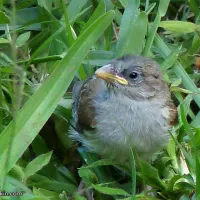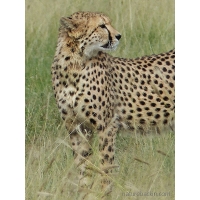Not all Kingfishers catch fish, as can be seen in this photo of a Brownhooded Kingfisher. Rather than a fish, he has just caught a cricket. This Kingfisher hunts by sitting on a low perch, in this case our garden fence, watching the ground for potential prey.
Although it is not one of the aquatic Kingfishers, “Roberts” does mention that Brownhooded Kingfishers do sometimes dive for fish, but not as expertly as those who specialise in catching fish. The Brownhooded Kingfisher’s main prey comprises insects, but they also catch small rodents, small reptiles and even small birds, as well as crabs and frogs. After softening up their prey they toss it back down the throat in one swift (and in this case blurry) movement.

Another of my favourite garden birds, Brownhooded Kingfishers are conspicuous in gardens in their range in the eastern regions of South Africa, both because they tend to perch in obvious places and because of their loud repetitive call. On one groggy morning, we tried to turn off the alarm clock, before realising that we’d been woken by the resident Kingfisher and not the alarm clock!

Fence sitting – the Kingfisher’s hunting style demands great patience, but their patience seems to be richly rewarded. Like all Kingfishers, the Brownhooded has an impressively large bill relative to its size – all the better to catch with. The Brownhooded does not have the flamboyant colours of some of the small Kingfishers, but when it flies the bright turquoise on its wings and back is eye-catching in a flash of brilliant colour.
Apart from parks and gardens, they also occur in woodland and forest edges and riverine and coastal bush. Usually, they are solitary or in pairs, the female having brown rather than black wings, and the juvenile being duller in colour than the adults.

Female or juvenile Broownhooded Kingfisher in our garden
Interestingly, this Kingfisher nests by tunnelling into banks or gulleys. In some suburban areas it may be difficult for them to find safe nesting sites. The tunnel, ending in a small chamber, is one metre long! Both parents dig the nest, but only the female incubates the eggs, although both parents are involved in feeding the chicks.
They spend a lot of time perching almost motionless watching for prey, but fly off very swiftly and, sadly, are prone to flying into windows. I have stuck paper cut-outs of flying birds on some of our windows to make the window panes more visible to swift-flying birds that might be confused by windows reflecting back the garden.★
Posted by Carol at letting nature back in
Source: Roberts Birds of Southern Africa (by Gordon Lindsay MacLean, 5th edition, 1985. Published by the Trustees of the John Voelcker Bird Book Fund, Cape Town).









October 15, 2016 at 7:58 pm
I’m so envious of your garden birds! Great photographs of this one, especially the first one with the cricket in its beak. Do they nest close by?
LikeLike
October 19, 2016 at 10:01 am
I assume they nest close by. There is a suitable place in the neighbouring commercial plantation, overgrown with thorny plants, best left undisturbed as it shelters many birds and other creatures.
LikeLike
October 10, 2016 at 7:57 am
thank you for taking the trouble to protect them from the windows!
LikeLike
October 10, 2016 at 8:40 am
Thanks for your comment, Hannelie. I guess that sometimes trying to be proactive even in small ways can make a difference?
LikeLike
October 10, 2016 at 12:21 am
Excellent photographs!
LikeLike
October 10, 2016 at 4:55 am
Thanks so much, Belinda.
LikeLiked by 1 person